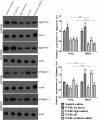Responses of human adipose-derived mesenchymal stem cells to chemical microenvironment of the intervertebral disc
- PMID: 22424131
- PMCID: PMC3338074
- DOI: 10.1186/1479-5876-10-49
Responses of human adipose-derived mesenchymal stem cells to chemical microenvironment of the intervertebral disc
Abstract
Background: Human adipose-derived mesenchymal stem cells (ADMSCs) may be ideal source of cells for intervertebral disc (IVD) regeneration, but the harsh chemical microenvironment of IVD may significantly influence the biological and metabolic vitality of ADMSCs and impair their repair potential. This study aimed to investigate the viability, proliferation and the expression of main matrix proteins of ADMSCs in the chemical microenvironment of IVD under normal and degeneration conditions.
Methods: ADMSCs were harvested from young (aged 8-12 years, n = 6) and mature (aged 33-42 years, n = 6) male donors and cultured under standard condition and IVD-like conditions (low glucose, acidity, high osmolarity, and combined conditions) for 2 weeks. Cell viability was measured by annexin V-FITC and PI staining and cell proliferation was measured by MTT assay. The expression of aggrecan and collagen-I was detected by real-time quantitative polymerase chain reaction and Western blot analysis.
Results: IVD-like glucose condition slightly inhibited cell viability, but increased the expression of aggrecan. In contrast, IVD-like osmolarity, acidity and the combined conditions inhibited cell viability and proliferation and the expression of aggrecan and collagen-I. ADMSCs from young and mature donors exhibited similar responses to the chemical microenvironments of IVD.
Conclusion: IVD-like low glucose is a positive factor but IVD-like high osmolarity and low pH are deleterious factors that affect the survival and biological behaviors of ADMSCs. These findings may promote the translational research of ADMSCs in IVD regeneration for the treatment of low back pain.
Figures






References
Publication types
MeSH terms
Substances
LinkOut - more resources
Full Text Sources
Other Literature Sources
Research Materials
Miscellaneous

